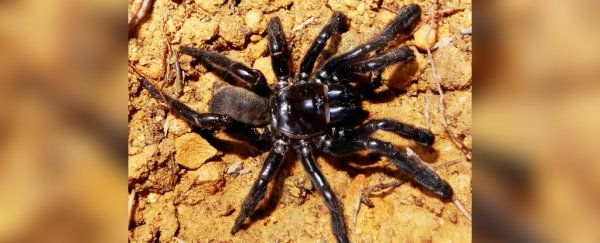If we had to guess an age limit for spiders, it would not have been as high as 43 years. But that's the surprising age at which an Australian female trapdoor spider recently passed away - breaking the record for observed spider longevity.
Number 16, as the Giaus villosus matriarch was known to researchers at Curtin University, broke the previous record of 28 years, the researchers said - living a full 15 years longer.
Tarantulas can live into their 20s, and it's thought that the Tasmanian cave spiders can live up to 40 years. However, the lifespan of a trapdoor spider had previously been set at a maximum of 20 years - so Number 16 might change how we research the wee beasties.
"To our knowledge this is the oldest spider ever recorded, and her significant life has allowed us to further investigate the trapdoor spider's behaviour and population dynamics," said lead author Leanda Mason, a biologist at the University's School of Molecular and Life Sciences.
Number 16 died during a long-term trapdoor spider population study initiated by Australian arachnologist Barbara York Main in 1974.
"Through Barbara's detailed research, we were able to determine that the extensive life span of the trapdoor spider is due to their life-history traits, including how they live in uncleared, native bushland, their sedentary nature and low metabolisms," Mason said.
Once trapdoor spiders (which look alarming, but aren't dangerous to humans) leave the nest of their mother, they disperse to dig their own miniature burrows, widening them as they grow, until they reach full adulthood around 5 years of age.
Female trapdoor spiders will occupy the same burrow for their entire life. Sexually mature males, on the other hand, will leave their nest purely in search of mating, and then die in the same season.
Trapdoor spiders also never utilise another burrow vacated by a dead spider. If their own burrows become damaged, they repair them or die - they don't relocate.
Number 16's burrow was first tagged during York Main's initial survey in 1974 as the burrow of a young spiderling - the 16th burrow, as her denotation indicates. By 2016, over 150 burrows had been tagged, but the first 15 spiders, and many subsequent ones, have died in the intervening years.
It's not known when Number 16 passed away, but it was sometime during that year.
"On 31 October 2016 we found that the lid of the burrow of the oldest spider, #16, had been pierced by a parasitic wasp," the researchers wrote in their paper.
"Having been seen alive in the burrow six months earlier, we therefore report the death of an ancient G. villosus mygalomorph spider matriarch at the age of 43."
With the burrow falling into disrepair, the researchers reached the conclusion that Number 16 was either already dead, or parasitised by a spider wasp, which lays its young inside spiders. Once the egg hatches, the spider is consumed by the larva from the inside out.
Trapdoor spiders are one of the most ancient species on Earth. They first appeared around the Triassic, and have remained relatively unchanged over the hundreds of millions of years compared to other spiders.
Their numbers are also declining - which is of great concern, considering they play a vital role in the Australian ecosystem, preying on other invertebrates.
By monitoring populations long-term, the researchers hope to observe the stresses that are playing a role in this worrying trend.
"These spiders exemplify an approach to life in ancient landscapes, and through our ongoing research we will be able to determine how the future stresses of climate change and deforestation will potentially impact the species," said co-author Grant Wardell-Johnson, director of the Curtin Institute for Biodiversity and Climate.
The team's research has been published in the journal Pacific Conservation Biology.
